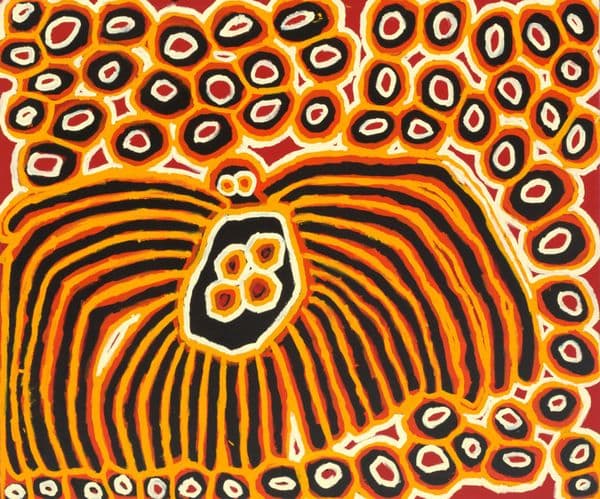Culture + Ceremony

Alan Griffiths, Ngarinyman/Ngaliwurru peoples, Waringarri dancers 2005, the Wesfarmers Collection, Boorloo/Perth © Alan Griffiths/Copyright Agency, 2022
timeless
adjective
without beginning or end; eternal; everlasting.
Oral history is the primary way that Indigenous stories, culture, language and history are memorised and immortalised. This accumulated cultural knowledge is passed down the generations through song and storytelling, exactly as their forebears recounted it. New experiences and knowledge add richness, depth and essential information to an already strong and dynamic culture. Oral histories are now supported by expanding archival and scientific evidence that confirms and continually extends the timeframe of Indigenous occupation of Australia.
The transfer of cultural knowledge continues in communities. For some communities, however, colonisation resulted in cultural knowledge being forcibly taken, denied or forgotten. As our Elders grow older and pass away, it becomes more urgent that their stories, life experiences and knowledge are recorded by artists, performers, writers, archivists, historians and videographers.
Cultural revival is increasingly occurring today, too, with the creation of new ceremonies and the recovery, through archival documentation and oral recordings, of Indigenous languages taken during colonisation.
Whether through art, song, dance or storytelling, the passing on of culture and ceremony is critical. As lifestyles change and people move away from their homelands, it becomes even more important for Elders to teach younger generations their ongoing responsibilities.
Alan Griffiths
‘I was in the bush for three years and never came back to the station. I learned everything I needed from that old fella … Our Dreamtime went through the Country. Country to Country. Bush life.’
Alan Griffiths (1933–2018) was born at Victoria River Station, Northern Territory, and lived in Kununurra in far northern Western Australia. He painted for the Waringarri Art Centre, established 40 years ago.
His painting Waringarri Dancers 2005 documents narratives of Country. He references ceremony and cultural stories and history. The characterised, rhythmic lines of figures are playful in contrast to the spiritual context of the painting, where he manifests his Ancestry and spiritual descendants.
Griffiths was an independent artist, a teacher of children, a printmaker and performance artist who also used sculptural forms in his art practice. He was a respected lawman, who interpreted his contemporary and cultural experience through painting. His life’s work celebrated his pride in his traditional childhood and cultural heritage.

Alan Griffiths, Ngarinyman/Ngaliwurru peoples, Waringarri dancers 2005, the Wesfarmers Collection, Boorloo/Perth © Alan Griffiths/Copyright Agency, 2022
Look
How has Griffiths organised this work? Can you see the dancers?
Think
How has Griffiths represented movement in his painting?
What was the first song/dance you learned in childhood?
Create
Make a line drawing of the first dance you remember doing as a child. You can use a coloured background with light or dark pencil marks to represent the song/dance.
Ken sisters
‘When we work together as a family, we are learning and teaching each other and our young sisters and daughters … this [is] important, Tjukurpa.’
Seven Sisters is a collaborative effort by Pitjantjatjara artists Tjungkara Ken, Sandra Ken, Yaritji Young, Freda Brady and Maringka Tunkin. Intuitively, the collective visually depicts their close connection to Tjukurpa (Dreaming story) in vibrant dot patterns, mapping the Seven Sisters’ journey across the landscape and into the cosmos.
The Seven Sisters is part of a significant Dreaming story that speaks of an Ancestral tale of kinship and the formation of star constellations present in our night sky.
In the spring and summer sky in the Southern Hemisphere, there is a cluster of stars known as the Pleiades, or Seven Sisters. An important part of the Community’s calendar, the appearance of the Seven Sisters in the sky marks the coming of summer.
Close to the Seven Sisters in the sky is the constellation Orion, or the saucepan. In Seven Sisters Dreaming, Orion is a pursuer of women in the Pleiades by a group of interested young men.

Tjungkara Ken, Sandra Ken, Yaritji Young, Freda Brady, Maringka Tunkin, Pitjantjatjara people, Seven Sisters 2018, National Gallery of Australia, Kamberri/Canberra, purchased 2020, © Tjunkara Ken, Sandra Ken, Yaritji Young, Freda Brady, Maringka Tunkin/Copyright Agency, 2022
Look
Observe the painting as a map of the sky, telling a story. What is this story? What elements do you notice?
Observe the skies where you live. Make notes or drawings of the stars you see.
Think
Why has the Seven Sisters story continued for over 40,000 years while Ancient Greek myths, for example, only go back 2,700 years? What might this say about oral traditions?
Create
Using your own observational sketches of your night skies, create your own version of the sky. In a group, join your works together. Begin painting over your stories, collaborating to make one sky that tells many stories.







